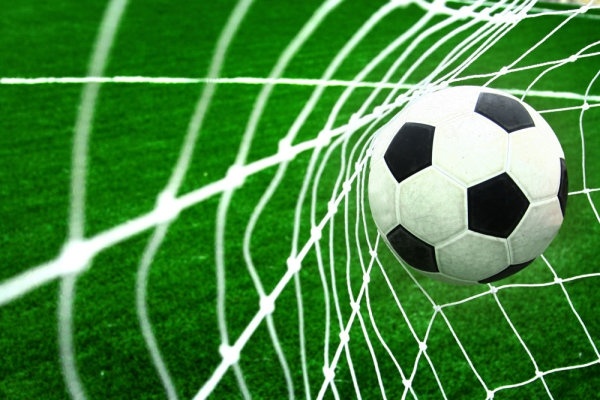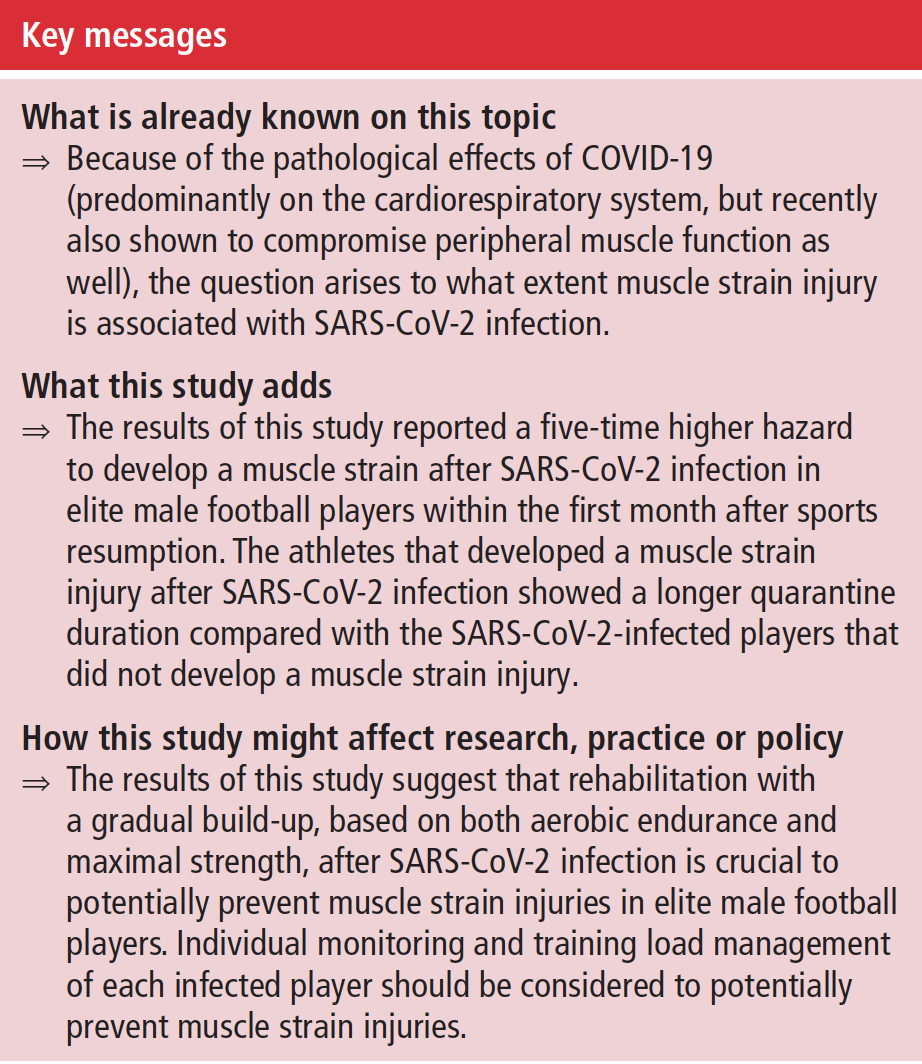Part of the BJSM’s #KnowledgeTranslation blog series
This study (recently published in the BJSM) was performed during the 2020-2021 season in three Belgian professional male football teams, aiming to investigate the association between SARS-CoV-2 infection and muscle strain injury in elite athletes.
Why is this study important?

The severe acute respiratory syndrome coronavirus 2 (SARS-CoV-2) is the coronavirus that causes coronavirus disease 2019 (COVID-19) (1). In order to limit the number of SARS-CoV-2 infections, several prevention measures were imposed, such as ‘social distancing’, the use of face mask and remaining in quarantine when showing symptoms. However, in team sports such as football, the use of face masks is very obstructive and personal contact between players is inevitable making it impossible to include the commonly suggested prevention measures. Another important approach to containing the SARS-CoV-2 outbreak is the requirement of infected patients to remain at home in quarantine, thereby minimizing physical contact and reducing the spread of the virus. This mandatory quarantine period for infected athletes could lead to a certain level of short-term detraining, resulting in a loss of training induced morphological and physiological adaptations in the muscular and the cardiovascular system (5). In addition, patients with SARS-CoV-2 infection can experience a range of pathological effects, predominantly on the cardiorespiratory system, but it has also been shown to compromise peripheral muscle function as well (4). And after the acute phase of COVID-19, there are now consistent reports that COVID-19 positive athletes may present persistent and residual symptoms after quarantine, including cough, tachycardia and (extreme) fatigue (6). Fatigue is a frequently reported symptom of COVID-19 but is also stated as a potentially significant risk factor for muscle injury (2). Thus, potential pathological effects of the SARS-CoV-2 infection in combination with short-term detraining effects due to quarantine could increase the risk of sustaining muscle strain injury on return to sport.
How did the study go about this?
The players of three professional teams were monitored for injuries and SARS-CoV-2 infections during the first half of the 2020-2021 season. Injury data was collected using established surveillance methods by each team’s medical staff. Assessment of SARS-CoV-2 infection was performed by a polymerase chain reaction (PCR) test before each official game. An overview of the infected players was documented by the team’s physician, including the days absent from training and the severity of COVID-19 symptoms (asymptomatic, mild, medium and severe). Time of exposure for training sessions and games were recorded at an individual level using Global Positioning System (GPS) data.
What did the study find?
The final cohort existed of 84 male participants, of which 22 were infected with SARS-CoV-2 during the follow-up period (June 2020 – January 2021). Varying severity of symptoms was demonstrated in these players (ranging from asymptomatic to severe). Additionally, 14 muscle strains (consisting of grade I and II muscle injuries) were registered over the three participating teams. Of these 14 players who developed muscle strain injury, 7 players (50%) had been previously infected with SARS-CoV-2. These players all developed their muscle strain injury within the first month after re-joining the team (on average 15.71 ± 11.74 days after the end of the quarantine period). In addition, players with a muscle strain injury showed a longer quarantine duration (14.57 ± 6.50 days) compared to the SARS-CoV-2 infected players who did not develop a muscle strain injury (11.18 ± 5.25 days). A significant association between SARS-CoV-2 infection and the development of muscle strain injuries was found (p=0.037, as shown below), indicating that the risk of developing a muscle strain was found to be 5 times higher following SARS-CoV-2 infection.
|
Multivariable analysis of the association between SARS-CoV-2 infections and muscle strain injury using Cox proportional hazards regression analysis (AIC= 53.9) |
|||
|
Indicator |
Hazard ratio | 95% Confidence Interval |
p-value |
|
BMI (kg/m2) |
2.0
5.1 |
1.2 – 3.1 | 0.004 |
|
SARS-CoV-2 infection |
1.1 – 23.1 |
0.037 |
|
In summary, our results found a five-times higher risk of developing muscle strain after a SARS-CoV-2 infection in elite male football players within the first month after sports resumption. The athletes that developed a muscle strain injury after SARS-CoV-2 infection showed a longer quarantine duration compared to the SARS-CoV-2 infected players that did not develop a muscle strain injury. Though caution is required when generalizing these results due to the small sample size and low number of strains, these findings require further exploration.
What are the key take-home points?
Although we are aware that periods of rest are not easy to apply in the context of the competition season, certainly in pandemic times when athlete availability can be highly compromised (7), sufficient periods of rest after infection and resolution of symptoms is highly recommended (3, 6). Afterwards, the results of this study suggest that rehabilitation with a gradual build-up, based on both aerobic endurance and maximal strength, after SARS-CoV-2 infection is crucial to potentially prevent muscle strain injuries in elite male football players. And individual monitoring and training load management of each infected player should also be considered to potentially prevent muscle strain injuries.

Author and Affiliation: Evi Wezenbeek, Department of Rehabilitation Sciences, Ghent University, Gent, Belgium
References:
- Cucinotta D and Vanelli M. WHO Declares COVID-19 a Pandemic. Acta bio-medica : Atenei Parmensis 91: 157-160, 2020.
- Huygaerts S, Cos F, Cohen DD, Calleja-González J, Guitart M, Blazevich AJ, and Alcaraz PE. Mechanisms of Hamstring Strain Injury: Interactions between Fatigue, Muscle Activation and Function. Sports (Basel) 8, 2020.
- Nieman DC. Risk of upper respiratory tract infection in athletes: an epidemiologic and immunologic perspective. Journal of athletic training 32: 344-349, 1997.
- Østergaard L. SARS CoV-2 related microvascular damage and symptoms during and after COVID-19: Consequences of capillary transit-time changes, tissue hypoxia and inflammation. Physiological reports 9: e14726, 2021.
- Sarto F, Impellizzeri FM, Spörri J, Porcelli S, Olmo J, Requena B, Suarez-Arrones L, Arundale A, Bilsborough J, Buchheit M, Clubb J, Coutts A, Nabhan D, Torres-Ronda L, Mendez-Villanueva A, Mujika I, Maffiuletti NA, and Franchi MV. Impact of Potential Physiological Changes due to COVID-19 Home Confinement on Athlete Health Protection in Elite Sports: a Call for Awareness in Sports Programming. Sports medicine (Auckland, NZ) 50: 1417-1419, 2020.
- Wilson MG, Hull JH, Rogers J, Pollock N, Dodd M, Haines J, Harris S, Loosemore M, Malhotra A, Pieles G, Shah A, Taylor L, Vyas A, Haddad FS, and Sharma S. Cardiorespiratory considerations for return-to-play in elite athletes after COVID-19 infection: a practical guide for sport and exercise medicine physicians. British journal of sports medicine 54: 1157-1161, 2020.
- Zaborova V, Gurevich K, Chigirintseva O, Gavrilov V, and Rybakov V. Pandemical Influence on Athletic Events and Communications in Sport. Frontiers in sports and active living 3: 653291, 2021.